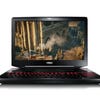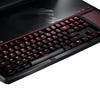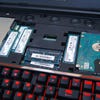MSI Titan GT80 Titan SLI review
Titan X-class desktop gaming power... in a laptop?
OK, it's provocative strapline but as the benchmark scores and FCAT analysis began to roll in, by and large it turns out to be a fairly accurate description of what this staggering piece of technology is capable of. MSI's frankly monstrous GT80 Titan SLI is a massive desktop replacement computer, which - in the case of our review sample, at least - features a Core i7 4890HQ quad-core processor, 32GB of RAM and two GTX 980M mobile GPUs working together in SLI, back by quad RAID-0 SSDs. It's a lavish, frankly immense spec, housed in an equally remarkable chassis.
The centrepiece of the GT80 Titan's casing is a back-lit, full height, SteelSeries mechanical keyboard, using Cherry MX switches. Good for 50 million button presses versus a conventional membrane keyboard's five to ten million, there's an exceptional durability about the design, but that's not really what makes this special - it's the feedback you get from using it, the feel of the keys as you press them and even the remarkable sound they make as they're pressed. For those of us of a certain age who've used a high-end 1980s workstation will know the feeling offered by this kind of keyboard. Functionally speaking, we daresay there's an advantage to this beautiful hardware in terms of accuracy, but this doesn't really excite us as much as the feeling of returning to a truly 'proper' keyboard after years mostly typing on our laptops. It's the sort of keyboard you'd use every 108 minutes in order to save the world.
Next to the keyboard sits the trackpad, capable of transforming into a back-lit number pad at the press of the button, but otherwise exceptionally responsive and backed by actual proper, clickable buttons at the bottom. There are only three other buttons - power, GPU, and fan. The first is self-explanatory, while the second is used to switch between discrete and integrated graphics, requiring a reboot (the software Optimus solution doesn't work on SLI set-ups). Finally, the fan button turns up the cooling solution to the max - which didn't seem to make a whole lot of difference to performance, but certainly kicked up a ton of mini-vac style noise.
Overall then, the core interface with the machine is quite wonderful, marred only by the fact that both keyboard and trackpad are right at the front of the case (the mechanical keys actually using the full height of the chassis), meaning that actually using the GT80 Titan as a laptop is a little more difficult than it should be, though MSI thoughtfully bundles a palm rest to lie in front of the unit on your desk. When you're dealing with a 4.5kg 'laptop' with an 18.4-inch display, the chances are you're probably not going to be lounging back on the chaise longue with it - we do recommend trying that though - it's by turns a somewhat surreal and strangely epic experience.
- Order the MSI Titan GT80 from Amazon with free shipping
The sheer real estate on offer means there's no shortage of ports either. The usual microphone and headphone jacks are supplemented with a Toslink SPDIF output, there are five USB 3.0 ports, Killer gigabit LAN, and HDMI 1.4 video. Bearing in mind the mammoth spec, the inclusion of a mere 1080p 60Hz display might seem a bit strange, but the rear of the unit has two mini DisplayPort outputs, meaning that 4K video at full-fat 60Hz is possible. We used them for capturing our FCAT benchmarks at 2560x1440, a demanding resolution that the basic GTX 980M struggles with on our test games - but which proves no real problem on most of our benchmarking suite when two of them are operating together in SLI.
Last but not least, the physical design of the unit features some elements of upgradability - release a couple of screws underneath and the top panel slides away, allowing you to replace the SSDs, RAM and optical drive. Removing the underside of the case gains you access to two more RAM slots, plus the two graphics cards. Right now there's nothing faster than the GTX 980M, but it's a worthwhile addition for both future-proofing - something MSI clearly thinks is important for this machine. Curiously, the CPU isn't upgradeable, but based on our benchmarks, only one game out of nine - Crysis 3, of course - shows any sign of CPU bottlenecks compared to a desktop Core i7 4790K overclocked to 4.6GHz. In contrast, our review unit packs an i7 4890HQ, capable of boosting to 4.0GHz (but more comfortable at 3.2GHz, based on our CPU stress tests).
The GT80 Titan SLI is a remarkable physical package then - as you might expect given the stratospheric £3,500 price-point - but it means nothing if it is not backed up by properly impressive gaming performance, and that's pretty much exactly what is delivered. We've been just a little concerned of late in the diminishing returns offered by high-end GPU configurations, be it full-fat GTX 980s in SLI or indeed the rampant Titan X. However, the GTX 980M is powerful, yet modest part in comparison to desktop alternatives. Performance-wise, it's about on par with the old GTX 780, but not quite as strong as a GTX 970 - but put two of them together and things get very interesting, as you'll see in these 1080p benchmarks:
| 1920x1080 (1080p) | GTX 970 | GTX 980 | GTX 980M | 980M SLI | Titan X |
|---|---|---|---|---|---|
| Battlefield 4, Ultra, 4x MSAA | 74.6 | 86.5 | 61.5 | 113.5 | 111.2 |
| Crysis 3, Very High, SMAA | 71.4 | 81.5 | 57.2 | 88.7 | 105.0 |
| Assassin's Creed Unity, Ultra High, FXAA | 51.7 | 62.4 | 42.0 | 82.6 | 77.6 |
| Far Cry 4, Ultra, SMAA | 77.4 | 87.4 | 61.6 | 115.5 | 101.5 |
| COD Advanced Warfare, Extra, FSMAA | 117.8 | 128.0 | 103.4 | 117.8 | 149.9 |
| Ryse: Son of Rome, High, SMAA | 65.1 | 75.8 | 53.1 | 101.9 | 99.2 |
| Shadow of Mordor, Ultra, High Textures, FXAA | 80.8 | 91.7 | 65.8 | 115.5 | 118.9 |
| Tomb Raider, Ultimate, FXAA | 102.4 | 118.2 | 84.0 | 163.4 | 150.4 |
| Metro Last Light Redux, Max, Post AA | 79.4 | 91.3 | 64.7 | 114.1 | 117.5 |
Full HD is an important resolution for the GT80 Titan SLI, as that's the resolution of the display you get with the machine, and as you can see from the benchmarks, just one GTX 980M has enough power to provide an excellent experience. Two of them in SLI means that locking gameplay to the exact resolution and refresh rate of the display should be achievable on all titles at the highest quality presets - as long as post-process anti-aliasing is used. What you don't see in the benchmarks is minimum frame-rate - all of the titles tested exceed 60fps here, except one: Crysis 3, which bottoms out at a still highly respectable 54fps.
SLI scaling is impressive. Diminishing returns kick in when using SLI with two desktop GTX 980s, to the point where an overclocked Titan X gets close to that raw performance in a great many titles. However, the multiplication factor of running two GTX 980Ms together is impresive - Assassin's Creed Unity, Far Cry 4, Tomb Raider and Ryse all offer 90 per cent plus boosts to performance. At the bottom of the pile is - you guessed it - Crysis 3, offering 'just' a 55 per cent boost. This does exclude Call of Duty Advanced Warfare from consideration though, with its paltry 14 per cent improvement. SLI support on that game is completely broken - with so much stutter added that turning off SLI for this title is the best way to play it. Averaging out the eight games where SLI is properly implemented, we see an 83 per cent boost to frame-rates overall.
Also worthy of mention is the consistency of performance, highlighted in our frame-time metrics contained in our benchmarking videos. In the vast majority of cases - Call of Duty apart - delivery of new frames is just as fluid in this SLI set-up as it is with the Titan-X. This leads us onto a remarkably conclusion: this gaming laptop is beating (albeit marginally) a desktop PC with the fastest single-chip GPU on the market working in combination with an overclocked i7 in five titles: Battlefield 4, Assassin's Creed Unity, Far Cry 4, Ryse and Tomb Raider, with little to separate them in Shadow of Mordor and Metro Last Light Redux. Again, factoring out COD, the mobile SLI set-up easily outperforms the desktop GTX 980, though only by the smallest of margins in Crysis 3. Running our Crysis 3 gameplay at 1440p challenge highlights this quite dramatically. Titan X gets close to a locked 60fps throughout, but the GTX 980M SLI only offers a modicum of improvement over the desktop GTX 980. It may well be that the less capable CPU in the GT80 Titan accounts for some of the hit here, particularly towards the end, but the close tracking between the GTX 980 and the GT80 SLI suggests we're mostly GPU-bound.
| Crysis 3 1440p60/V-Sync Gameplay | GTX Titan X | GTX 980 | GTX 980M SLI |
|---|---|---|---|
| Lowest Frame-Rate | 44.0fps | 31.0fps | 35.0fps |
| Dropped Frames (from 18650 total) | 477 (2.56%) | 3852 (20.66%) | 2841 (15.23%) |
Similar to its 1080p performance, Crysis 3 at 1440p is at the lower end of the SLI set-up's scalability - generally speaking, the Titan GT80 SLI still works plenty of magic at 2560x1440. We see some phenomenal results here, particularly in the case of Assassin's Creed Unity, Battlefield 4, Ryse and Tomb Raider, all of which come close to a full doubling of performance over a single 980M. Far Cry actually sees a more than 2x increase in performance - which seems implausible, but is confirmed after retesting. Minimum frame-rates during the test sequences are also sturdy - Crysis 3 and AC Unity faring worse at 39fps and 44fps respectively, but in most cases a locked 60fps is still on the table, even if some minor settings tweakage is required. It's important to remember here that anti-aliasing aside, we're running on max settings in all of these benches, meaning there's plenty of room to tweak with only a minimal hit to image quality.
It might seem like overkill to have this much GPU power on tap for a mere 1080p display, but the possibilities here are still enticing. Firstly, there's nothing stopping you connecting up the GT80 Titan to an external display, capable of a much higher resolution. Secondly, Nvidia has its own downscaling tech - DSR. In effect, the driver allows you to select much higher resolutions in-game, downscaling them dynamically to run on the 1080p display. This is a process known as super-sampling, and it is by far the most effective form of anti-aliasing you can get. It's pure brute-force, but the twin GTX 980Ms clearly have the potency to deliver solid results. The only problem here? DSR doesn't seem to be available yet in Nvidia's mobile drivers, which is bizarre considering the silicon is identical to the desktop equivalent.
However, the more limited SLI gains from Crysis 3, not to mention the fundamentally broken Call of Duty Advanced Warfare do serve to remind us that the raw power of this machine is dictated to a large extent by the quality of any given title's SLI implementation, which clearly varies on a per-game basis. Let's not forget that it took several months for Titanfall to gain SLI compatibility at all - in the meantime, players with two or more Nvidia graphics cards would have been lumbered with single GPU support only, or hacked together community fixes.
| 2560x1440 (1440p) | GTX 970 | GTX 980 | GTX 980M | 980M SLI | Titan X |
|---|---|---|---|---|---|
| Battlefield 4, Ultra, 4x MSAA | 48.9 | 57.0 | 40.8 | 77.2 | 75.1 |
| Crysis 3, Very High, SMAA | 43.0 | 50.0 | 35.3 | 55.6 | 67.0 |
| Assassin's Creed Unity, Ultra High, FXAA | 32.8 | 39.4 | 26.8 | 53.6 | 51.6 |
| Far Cry 4, Ultra, SMAA | 53.9 | 61.3 | 42.7 | 93.5 | 78.6 |
| COD Advanced Warfare, Extra, FSMAA | 87.0 | 98.2 | 75.7 | 91.3 | 114.6 |
| Ryse: Son of Rome, High, SMAA | 46.3 | 54.1 | 37.7 | 72.7 | 71.4 |
| Shadow of Mordor, Ultra, High Textures, FXAA | 57.0 | 66.0 | 47.1 | 82.0 | 85.3 |
| Tomb Raider, Ultimate, FXAA | 65.5 | 76.7 | 54.8 | 103.9 | 101.7 |
| Metro Last Light Redux, Max, Post-AA | 48.9 | 58.3 | 40.8 | 68.0 | 74.5 |
Put simply, the MSI GT80 Titan SLI is a performance powerhouse - immensely over-specced in many ways, but with proven results that truly impress. As long as SLI works properly on your games of choice, you're looking at a machine that exceeds the capabilities of a desktop machine sporting the GTX 980, or even Titan X, depending on the title. What's also impressive is the power consumption. The unit comes with a meaty 350W power brick, and according to our measurements with a watt meter, it gets a thorough workout, with consumption rising to a maximum of 310W. Bearing in mind that our Titan X desktop machine (using an overclocked 4790K) hit a peak 364W in the same tests, the fact that the laptop achieves equivalent results using less juice is clearly rather impressive. But 310W is still a substantial power draw for a mobile device, and at full pelt, the cooling assembly is genuinely loud - we measured 60dB at the keyboard. On top of that, it's worth pointing out on battery, gaming frame-rates plummet - the eight-cell battery simply cannot provide the level of power you get from the wall. Frame-times here also suffer, and Nvidia's battery boost tech does little to improve the quality of the experience.
The issue of battery life leads us onto another gripe we have with the Titan GT80 SLI - stamina away from the mains is very, very low. Even on basic tasks, you're looking at around two hours with the dedicated graphics enabled, while dropping down to integrated sees that double - but four hours' life on a light workload still isn't great. Of course, a desktop replacement is likely to spend much of its life plugged in, and a 4.5kg PC with these colossal dimensions isn't likely to find much use 'on the go', but regardless, it seems that quad-core Intel chips aren't anything like as power-efficient as the dual-core versions. More battery power would have been nice, but would have added even more weight.
There are other drawbacks too: sound reproduction is unimpressive overall with a distinct lack of bass, to the point where a 13-inch MacBook Air produces a richer, fuller sound across the range. This is offset to a certain degree by the excellent display - utilising Samsung PLS technology, it's extremely bright, and while not totally accurate in terms of colour reproduction, it puts on a great show for gaming.
MSI GT80 Titan SLI - the Digital Foundry verdict
MSI aimed to create the ultimate desktop replacement with the Titan GT80 SLI and by and large, it has delivered. Performance is frankly awesome for a portable unit, the screen is good and the core interface - the keyboard especially - is superb. Response in Windows is extremely fast owing to the quad RAID-0 SSD array, and there's still room inside the chassis for additional storage - in the case of our review unit, a 1TB 2.5 inch drive is included, and the chances are that the in-built optical drive could be swapped out for an additional storage caddy too. While upgrade potential is always more limited in a laptop, MSI says that it will offer support for GPU upgrades across two generations, meaning that - in theory at least - the fastest gaming laptop on the market today could still retain its status two or even three years down the line. Of course, the question is just how much it will cost to replace those GPUs - MXM module graphics cards are always much more expensive than desktop equivalents.
Of course, the price of this entire endeavour is immense: we're looking at £3,500 for the extreme spec model we're reviewing here. Bundled extras like a gaming mouse, backpack, metal WASD keycaps and the palmrest are nice extras, but that's still an enormous price to pay. There's little doubt that you could build a Titan X-based mini-ITX cube with a Devils Canyon i7 processor and still have cash left over for a high-end ultrabook, but to think along these lines is to apply some semblance of reason and logic to a market sector where the audience simply doesn't seem to care. It can easily be argued that any of these outsized desktop replacements offer questionable value - and yet they keep on coming.
There's clearly a market for products like this - as niche as it may be - and when you physically have the GT80 Titan SLI in your possession, you can kind of see why. Despite its ginormous price tag, questionable battery life and loud fans, this PC is pushing back technological boundaries in new and exciting ways. It crams an almost absurd amount of performance into a relatively portable form factor, while the upgradability and the superb keyboard make it feel like a special, one of a kind product. Its sheer insanity may justifiably stupefy the majority of the PC audience, but for that tiny, affluent niche this machine was made for, its charms may well prove irresistible.





















